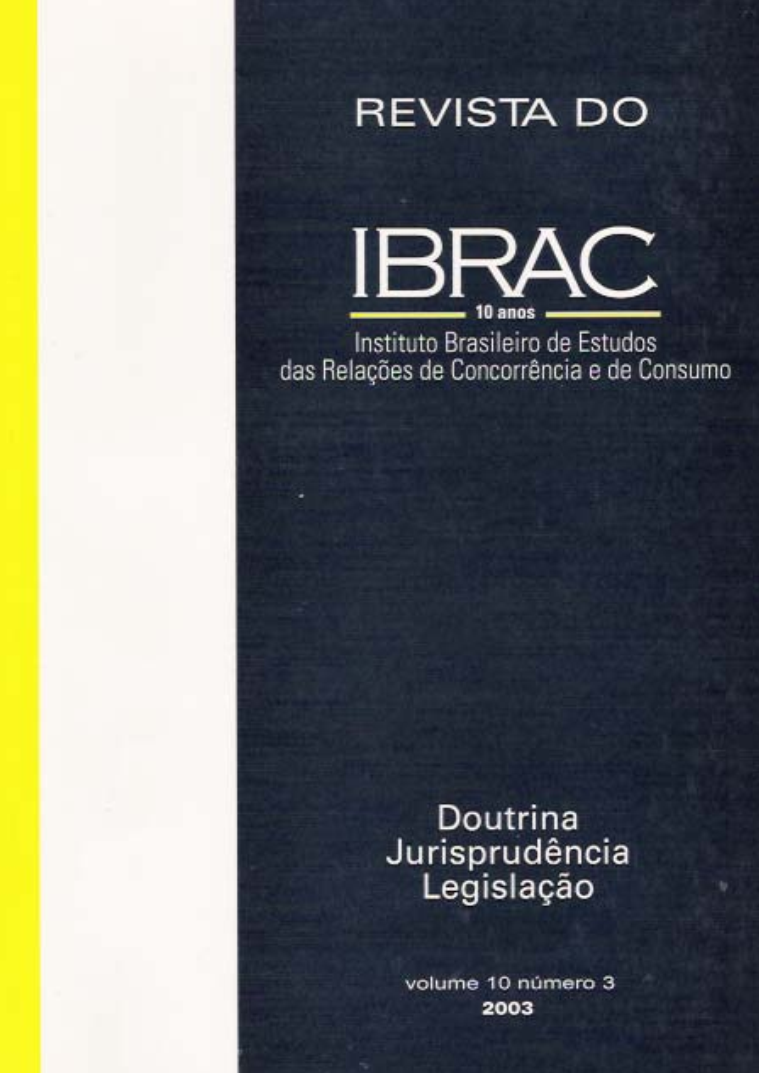Legal and economic interfaces between antidumping and competition policy
Conteúdo do artigo principal
Resumo
The interaction between antidumping and antitrust is a polemic issue in every integration process for both legal and economic reasons. From a legal perspective, antidumping rules allow practices such as price undertakings and quantitative trade restrictions that may be forbidden by competition law, and punish certain types of price differentiation that are justifiable under the antitrust rules. From an economic viewpoint, the two policies pursue different objectives that eventually may lead to conflicting situations. Antidumping is a trade remedy for industries injured by import competition. The final goal of antitrust is to promote consumer welfare and productive efficiency, which in part depend upon market contestability, wherein import competition often plays a key role.
Downloads
Detalhes do artigo

Este trabalho está licenciado sob uma licença Creative Commons Attribution 4.0 International License.
Referências
BLONIGEN, B. A. (1999). “Foreign Direct Investment Responses of Firms Involved in Antidumping Investigations”. Discussion Paper, University of Oregon.
BLONIGEN, B. A.; PRUSA, T. J. (2001). “Antidumping”. NBER Working Paper 8398, Cambridge, MA.
BOURGEOIS, J.; DEMARET, P. (1995). “The Working of EC Policies on Competition, Industry and Trade: a Legal Analysis”. In: BUIGUES, P.; JACQUEMIN, A.; SAPIR, A. (eds.). European Policies on Competition, Trade and Industry: Conflict and Complementarities. Aldershot, U.K.; Brookfield, U.S.: Edward Elgar.
PRIMO BRAGA, C.; SILBER, S. (1993). “Brazilian Frozen Concentrated Orange Juice: The Folly of Unfair Trade Cases”. In: FINGER, M. (ed.). Antidumping: How it Works and Who Gets Hurt. University of Michigan Press.
DAM, K. W. (2001). The Rules of the Global Game. University of Chicago Press.
DAVIDOW, J. (1999). “Rules for the Antitrust/Trade Interface”. Ablondi, Foster, Sobin & Davidow, p.c. Washington, D.C.
FINGER, J. M. (1993). “The Origins and Evolution of Antidumping Regulations”. In: FINGER, J. M. (ed.). Antidumping: How It Works and Who Gets Hurt. University of Michigan Press.
FINGER, J. M. (1998). “GATT Experience with Safeguards: Making Economic and Political Sense of the Possibilities that the GATT Allows to Restrict Imports”. World Bank Policy Research Working Paper 2000, Washington, D.C.
GREENSPAN, A. (1999). “Technology and Trade”. The Dallas Ambassadors Forum, Dallas, Texas. Disponível em: http://www.federalreserve.gov.
JONES, C.; LEE, D. S.; SHIN, A. (2001). “Antitrust Violations”. American Criminal Law Review, v. 38.
HART, M. (1997). Finding Middle Ground: Reforming the Antidumping Laws in North America. Canada: Centre for Trade Policy and Law.
HOEKMAN, B.; MAVROIDIS, P. C. (1996). “Dumping, Antidumping and Antitrust”. Journal of World Trade, v. 30, n. 1, fev.
HORLICK, G. (1989). “The United States Antidumping System”. In: JACKSON, J. H.; VERMULST, E. A. (eds.). Antidumping Law and Practice. The University of Michigan Press.
LINDSEY, B.; IKENSON, D. (2001). “Coming Home to Roost Proliferating Antidumping Laws and the Growing Threat to U.S. Exports”. CATO Institute Trade Policy Analysis 14, Washington, D.C.
LIPSTEIN, R. A. (1997). “Using Antitrust Principles to Reform Antidumping Law”. In: GRAHAM, E. M.; RICHARDSON, J. D. (eds.). Global Competition Policy. Washington, D.C.: Institute for International Economics.
LLOYD, P. J. (2001). “Anti-Dumping Action and Competition Law”. Discussion paper, University of Melbourne, Australia.
LLOYD, P. J.; VAUTIER, K. M. (1999). Promoting Competition in Global Markets: A Multi-National Approach. Cheltenham, U.K.: Edward Elgar.
MARCEAU, G. (1994). Anti-dumping and Anti-trust Issues in Free-Trade Areas. Oxford University Press.
MESSERLIN, P. A. (1990). “Antidumping Regulations or Pro-Cartel Laws? The EC Chemical Cases”. World Economy, v. 13.
MESSERLIN, P. A. (1996). “Competition Policy and Antidumping Reform”. In: SCHOTT, J. J. (ed.). The World Trading System: Challenges Ahead. Washington, D.C.: Institute for International Economics.
MESSERLIN, P. A.; THARAKAN, P. K. M. (1999). “The Question of Contingent Protection”. The World Economy, v. 22, n. 9, dez.
MIRANDA, J.; TORRES, R. A.; RUIZ, M. (1998). “The International Use of Antidumping: 1987-1997”. Journal of World Trade, v. 32, n. 5, out., Genebra.
NICOLAIDES, P.; VAN WIJNGAARDEN, R. (1993). “Reform of Anti-Dumping Regulations – The Case of the EC”. Journal of World Trade, v. 27, n. 3, jun., Genebra.
PIERCE, R. J. (2000). “Antidumping Law as a Means of Facilitating Cartelization”. Antitrust Law Journal, v. 67, n. 3.
PRUSA, T. J. (1992). “Why Are So Many Antidumping Petitions Withdrawn?”. Journal of International Economics, v. 33.
PRUSA, T. J. (1996). “The Trade Effects of U.S. Antidumping Actions”. NBER Working Paper 5440.
STIGLITZ, J. E. (1997). “Dumping on Free Trade: The US Import Trade Laws”. Southern Economic Journal, v. 64.
TAVARES, J. (1998). “Trade, Transparency and Competition: FTAA and CER”. Journal of Latin American Competition Policy, v. 1, Edição Especial, dez. Disponível em: http://www.sice.oas.org/tunit/pubinfoe.asp.
TAVARES, J. (2001). “Trade and Competition in B2B Markets”. OAS Trade Unit Studies. Disponível em: http://www.sice.oas.org/tunit/pubinfoe.asp.
TAVARES, J.; MACARIO, C.; STEINFATT, K. (2001). “Antidumping in the Americas”. Journal of World Trade, v. 35, n. 4, ago. Disponível em: http://www.sice.oas.org/tunit/pubinfoe.asp.
TAYLOR, Christopher T. (2001). “The Economic Effects of Withdrawn Antidumping Investigations: Is There Evidence of Collusive Settlements?”. Federal Trade Commission Bureau of Economics Working Paper 240, Washington, D.C.
U.S. DOJ ANTITRUST DIVISION; FEDERAL TRADE COMMISSION (1995). “Antitrust Enforcement Guidelines for International Operations”. Department of Justice, Washington, D.C. Disponível em: http://www.usdoj.gov.
U.S. GOVERNMENT (1998). “Observation on the Distinctions between Competition Laws and Antidumping Rules”. World Trade Organization WT/WGTCP/W/88, Genebra.
U.S. INTERNATIONAL TRADE COMMISSION (1995). “The Economic Effects of Antidumping and Countervailing Duty Orders and Suspension Agreements”. Investigation No. 332-344, USITC Publication 2900, Washington, D.C.
U.S. INTERNATIONAL TRADE COMMISSION (1999). “Ferrosilicon from Brazil, China, Kazakhstan, Russia, Ukraine, and Venezuela”. Investigation No. 751-TA-21-27, USITC Publication 3218, Washington, D.C.
VAN BAEL, I. (1996). Anti-dumping and other trade protection laws of the EC. Bicester: CCH Editions.
VON KALINOWSKI, J. O. (2001). Antitrust Laws and Trade Regulation. 2ª ed. Nova York: Matthew Bender & Company Inc.
ZANARDI, M. (2000). “Antidumping Law as a Collusive Device”. Boston College Working Paper 487, Boston, M.A.

